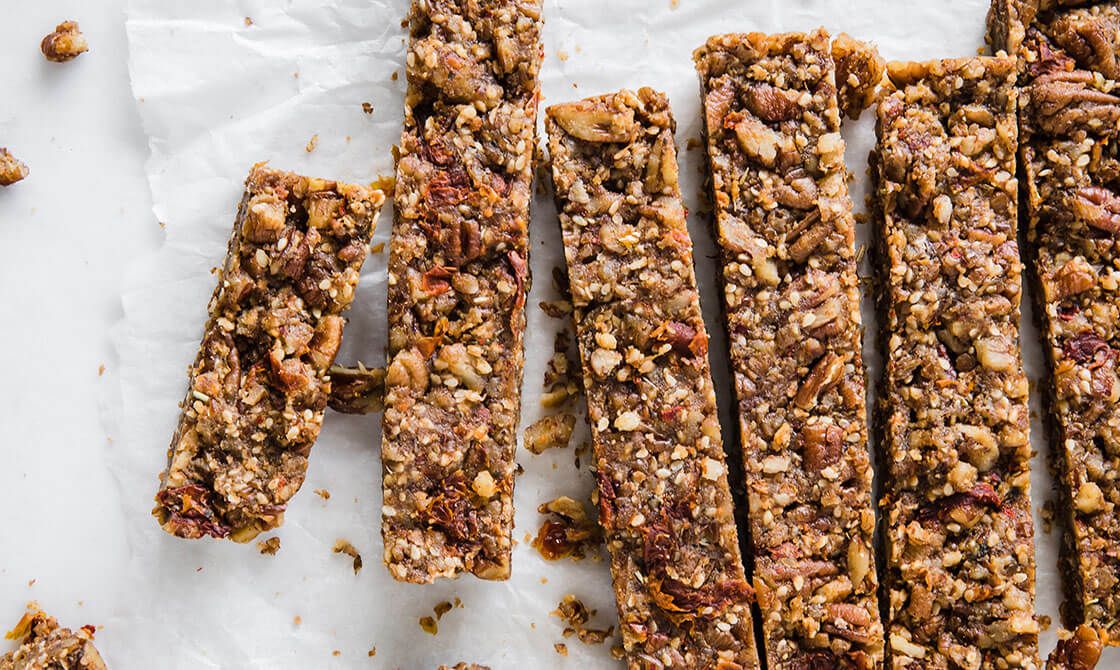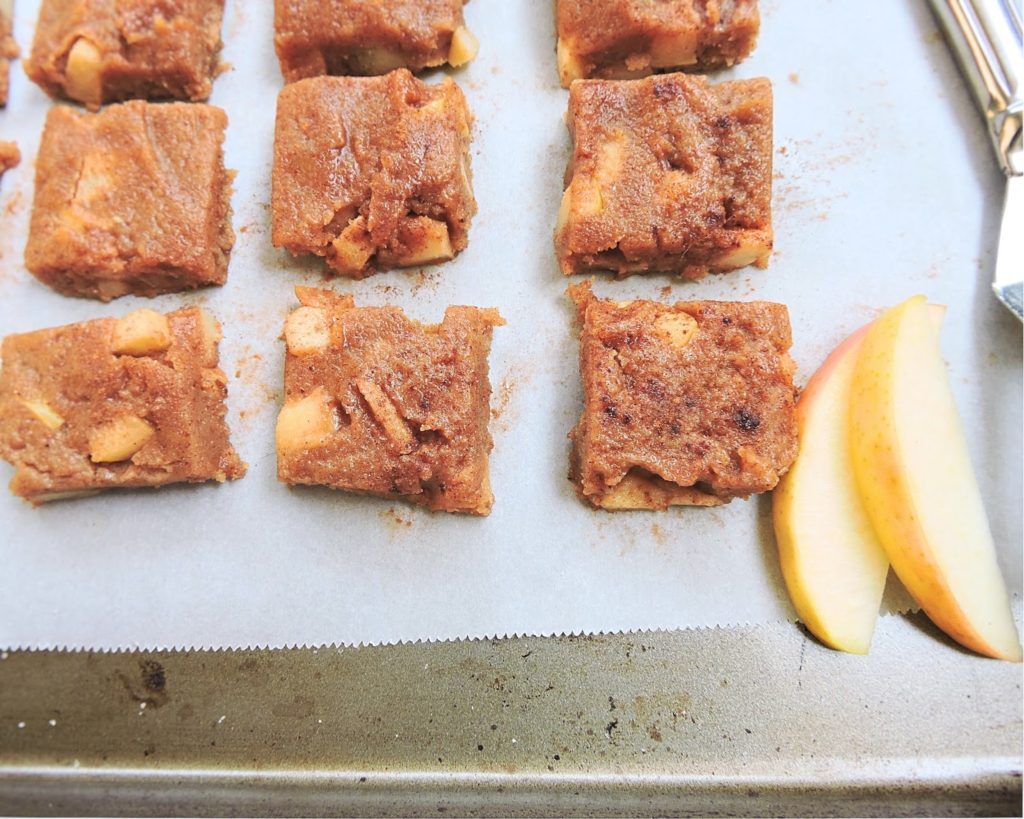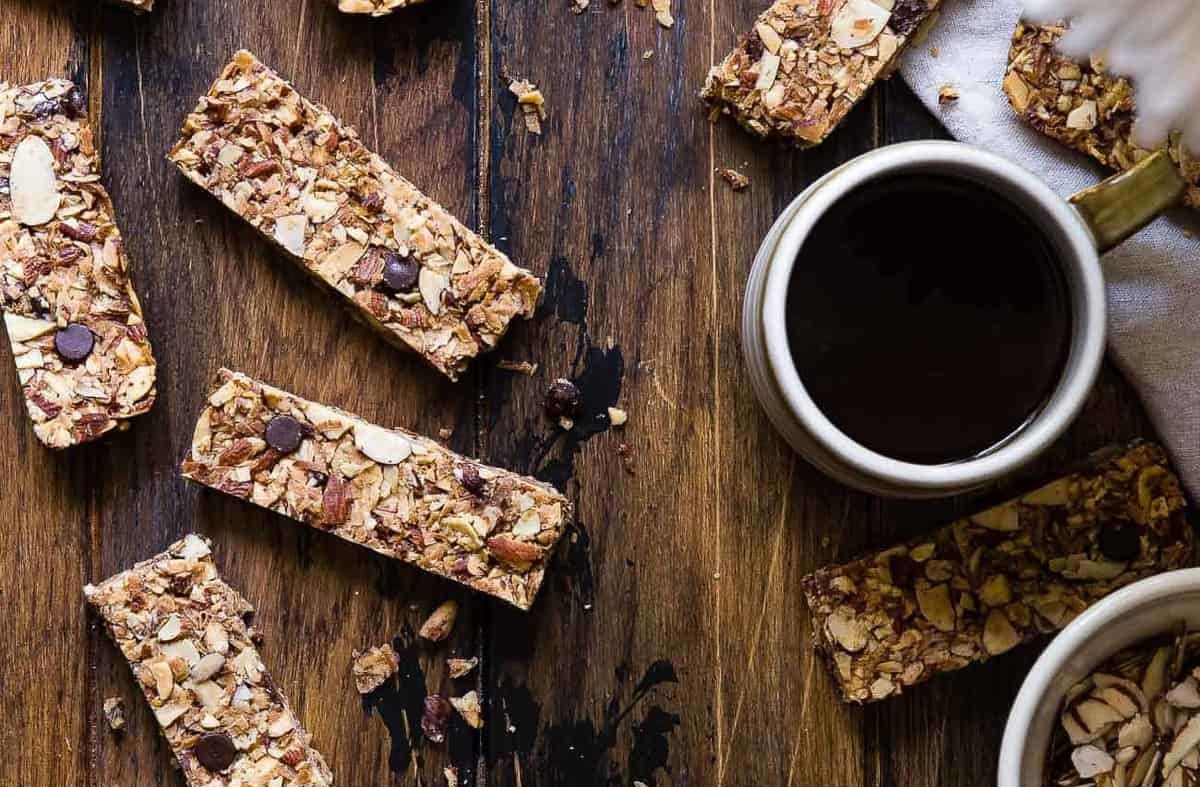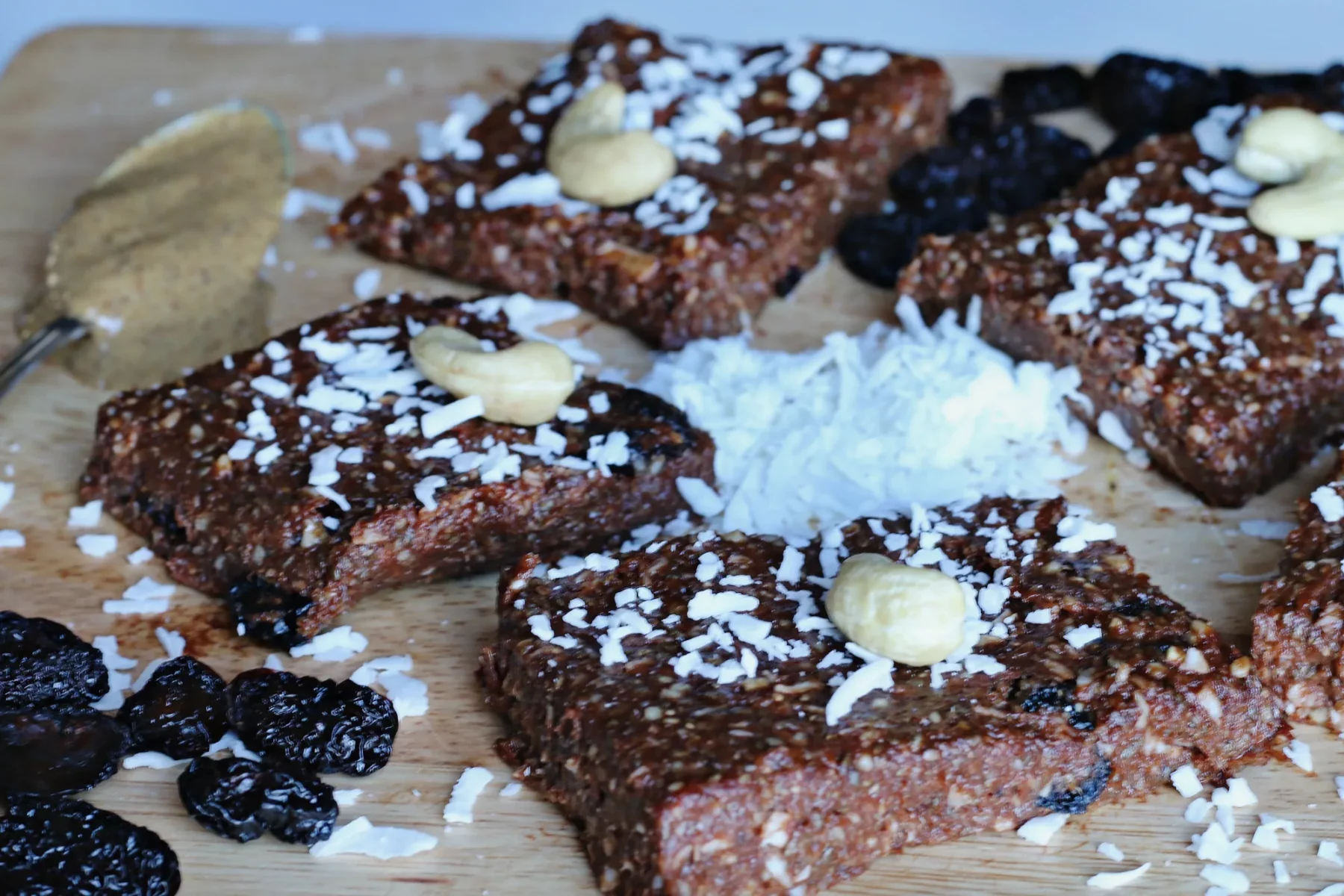
The best snack bars for better blood sugar
They may look like health food, but many snack and energy bars have as much sugar as a candy bar. Here are six recipes to DIY a better version.
Energy bars are an easy way to keep some calories handy when you’re on the go or need a quick snack at home. And since they often contain whole grains, nuts, and fruit, they seem like a smart choice.
But even snack bars with healthy-sounding ingredients are often loaded with sugar. [Sweetener](http://The best snack bars for better blood sugar), usually in the form of syrup, is the first or second ingredient in many bars. This alone can cause your blood sugar and energy to rise and crash; adding quick-digesting carbs such as rice crisps or oat flour only increases the effect.
For example, looking at data from Levels members’ food logs, “Clif bar” scores 4.5 (out of 10) with an average glucose rise of +38 mg/dL, which is pretty significant. “Granola bar” doesn’t do much better, at 5.7 and +32 mg/dL. Then factor in processed oils, which can promote inflammation in your body, and it’s not a pretty picture from a health standpoint.
That said, plenty of snack bars can curb hunger, deliver nutrition, and keep blood glucose levels steady. By knowing what to look for—or making your own—you can raise the bar for your metabolic health.
The Problem with the Typical Snack Bar
Snack bars are marketed as energy boosters that deliver nutrition. While that’s true for some, others can wreak havoc on your blood sugar: One popular energy bar serves more sugar and carbs than a candy bar. Let’s break down some common ingredients in snack bars and take a closer look at how they can affect your metabolic health.
- The base: The first, second, or third ingredient in many snack bars is a sweetener such as brown rice, cane, tapioca, date, or maple syrup. These are made by breaking down starches into sugars and reducing them into a syrupy consistency. They’re added to sweeten and bind together ingredients. While each has its own nutrient profile, these syrups add a serious dose of sugar. Organic brown rice syrup contains 10 grams of sugar per tablespoon compared to the 12 grams of sugar in the same amount of regular table sugar. Foods high in sugar are digested quickly, causing a rapid rise in blood sugar. This can then lead to a quick blood sugar drop and a crash in your energy and mood. (Fiber, fat, and protein in bars can help balance this out to a degree, but responses will vary from person to person.) Over time, blood sugar swings like this can take a toll on your metabolic health and set the stage for inflammation, insulin resistance, and Type 2 diabetes.
- Extra sweeteners: That first added sugar often isn’t the last. One popular bar contains three kinds of syrup for a total of 16 grams of added sugar (note that barley malt extract or syrup is also a sneaky natural sweetener). Other sweeteners, including honey, molasses, apple juice concentrate, cane sugar, and fruit purees, are also common in snack bars.
- More carbs: Rice crisps, oats, and rice and oat flour add substance to snack bars. But your body breaks down these carbs quickly, turning them into glucose that’s rapidly absorbed into the bloodstream. This can further drive up your blood sugar in a short period.
- Refined oils: Many snack bars contain processed seed and vegetable oils such as soybean, safflower, corn, and sunflower. These extracted oils are usually heated to high temperatures, which can accelerate oxidation. They’re also high in omega-6 fatty acids, a type of fat that’s often added to processed and fried foods. Some experts, including Levels advisor and pediatric endocrinologist Robert Lustig, M.D., say that a higher ratio of omega-6 to omega-3 fatty acids in the diet increases inflammation in the body. Other research ties too many omega 6s to weight gain and a greater risk of obesity.
- Chicory root: Chicory is a leafy green plant with a fiber-rich root. It contains a type of fiber called inulin, which is used to increase the fiber profile or add sweetness to packaged foods like bars. Inulin is a type of prebiotic, which means it feeds your gut bacteria. Research suggests that inulin may help keep blood sugar levels steady. But too much inulin can trigger digestive issues such as bloating, flatulence, and stomach pain.
When shopping for a snack bar, you want to limit these ingredients—and it’s tough to find options that meet these standards. Certain meat-based bars, such as those by Epic Provisions, fit the bill. Others include Perfect Keto Almond Butter Brownie or Superfood Bars from Paleovalley.
One more thing to watch in store-bought bars: the low-sugar options often use sugar alcohols as the sweetener. While these are generally well-tolerated, they can cause GI distress in some people. Try to stay under 10-15mg a day.
Build a Better Snack Bar
Because store-bought options are limited (and often pricey), we recommend making your own snack bars. To get started, follow these steps:
1. Start with nuts
Nuts serve up fat, protein, and fiber to help tamper blood glucose response. They also deliver magnesium, arginine, and polyphenol antioxidants, all of which protect cells against damage. Research shows that women who averaged two or more 1-ounce servings of walnuts (roughly 14 halves) each week were 24 percent less likely to develop Type 2 diabetes than those who didn’t eat them regularly. Experts think this is because the fiber, healthy fats, and nutrients in walnuts may help reduce inflammation and stabilize blood sugar. Nut butters also help bind a bar together. Some processed nut butters contain added sugars; use an all-natural nut butter or make your own by blending nuts in a food processor or high-speed blender.
2. Add protein
Unsweetened protein powder can help keep blood sugar steady. In one study, scientists had people with Type 2 diabetes eat the same lunch with and without an added whey protein supplement. Two hours later, their blood glucose level was 21 percent lower after consuming the protein-enriched meal compared to the regular one.
There are many different kinds of protein powders. Good options include:
- Casein: A type of milk protein, casein is digested more slowly than whey. This may cause you to feel full for longer, potentially leading to weight loss. Note that dairy is an insulin secretagogue, meaning it spurs a greater insulin release than expected based on the glucose load. Whether or not that extra insulin is damaging is still debated.
- Pea protein: This plant-based powder is made from split peas. Research shows that pea protein powder may help keep blood sugar levels in check, but not to the same degree as casein.
- Egg white protein: Early research suggests that eggs may benefit metabolic health, thanks to their high protein content.
3. Use fruit as an accent
Dried fruits such as dates, raisins, and berries are high in fiber, so they’re less likely to trigger the same rapid blood sugar spike as straight-up sugar or syrups. They also serve up doses of magnesium, which plays a crucial role in managing blood sugar and insulin levels. And potassium—another mineral in dates, raisins, and other fruit—sharpens insulin sensitivity and reduces the risk for metabolic problems.
But it’s important to add these fruits sparingly—particularly dates, which are very sweet. In larger quantities, they can cause glucose levels to climb, especially when mixed with other carbs and sweeteners.
4. Sweeten smartly (if you must)
Sugars and syrups can send your blood glucose level soaring, while artificial sweeteners may be problematic for your metabolic health. Instead, consider a natural sweetener that won’t wreak havoc on your blood sugar, such as stevia, monk fruit, or allulose.
6 Healthy Snack Bar Recipes to Try
Ready to make your own healthy grab-and-go snack? Whether you prefer savory, sweet, chocolatey, or fruity, we’ve got you covered. These snack bars can keep you full while maintaining stable blood sugar levels.
Coconut Almond Bars
The main two ingredients, soaked almonds and nut butter, provide protein and fiber, while flaxseed offers heart-healthy omega-3 fats. Shredded coconut, vanilla, sea salt, and cacao chips add a salty-sweet punch to these no-bake bars.
Image courtesy KetoMojo
Garlic and Herb Granola Bars
These savory bars are packed with flavor thanks to sundried tomatoes, chili flakes, Italian herbs, and other spices. Pecans, sesame seeds, tahini (a sesame paste), and an egg deliver 7.5 grams of protein and 5 grams of fiber per bar.
Image courtesy JustJessieB
Almond Butter Apple Pie Bars
Made with applesauce, cinnamon, and apple chunks, these creamy bars taste like apple pie. Almond flour and butter add protein (9 grams per bar) and healthy fats to keep blood sugar levels stable. These bars are best eaten cold, so they work better as a fast breakfast than a portable snack.
Image courtesy FoodFaithFitness
Low-Carb Granola Bars
These bars are loaded with raw almonds, slivered almonds, and almond butter and sweetened with monk fruit, chocolate chips, and coconut flakes.
Image courtesy BeingBrigid
Cherry Chocolate Bars
Soaking chia seeds in almond milk creates a gel high in omega- 3s and fiber. That’s combined with cashews, collagen powder, and almond butter, and sweetened with cocoa powder, dates, and dried cherries.
Image courtesy LifeMadeSweeter
Nut-and-Seed Granola Bars
A mix of nuts and seeds, including almonds, pecans, sunflower seeds, and hemp seeds, are the centerpiece of this recipe. Vanilla, coconut flakes, and monk fruit lend a touch of sweetness.

Take control of your metabolic health
Levels helps you see how food and lifestyle affect your health through macro tracking, habit-building, and customized insights and advice. Levels members can also incorporate biomarker data like real-time glucose and metabolic blood testing for an even more personalized experience. Click here to get started with Levels.










